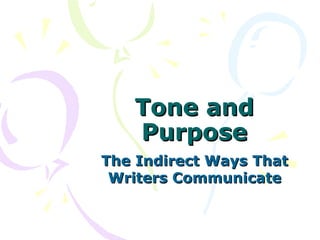
Understanding Tone, Purpose and Indirect Communication
- 1. Tone and Purpose The Indirect Ways That Writers Communicate
- 2. Understanding the Author’s Purpose In many textbooks, the writer’s purpose is fairly clear. However, sometimes a writer will express an opinion indirectly. Writers use tone, style and other features of language to achieve the results they want.
- 3. Understanding Tone Refers to the author’s Examples attitude toward his/her Instructive subject. Sympathetic Think of how you interpret Persuasive Nostalgic the tone of a speaker’s voice Humorous Pay attention to word Angry choice, types and length of Insensitive sentences, description Naive Tone is important in determining the author’s purpose.
- 4. Style and Intended Audience Style may be defined as the characteristics that make a writer unique. Depending upon whom the writer is addressing, he will change the level of language, method of presentation, and word choice. Writing may be academic, technical, formal, or informal.
- 5. Language Objective Subjective factual Express attitudes, feelings & opinions Authors use language in special ways to help the reader understand and create a picture of a situation. Create Descriptions Making comparisons Using symbols
- 6. Word Choice Connotative Denotative Meanings Meanings – Opposite of – Literal Meaning Denotation found in the – Implied Meaning dictionary – A Word’s Nuance— – Factual, exact ideas associated – No added meanings with the word’s usage – May be positive or negative
- 7. Connotation positive vs. negative • Request, demand, • Crowd, mob, gang, command, appeal, audience, class, plead, claim, ask congregation • Gaudy, showy, • Slim, skinny, slender, flashy, tawdry, slight, wiry, scrawny glitzy, jazzy • Intelligent, brainy, • Glance, stare, look, nerdy, smart, gifted glimpse, peek, • Particular, picky, peer, examine, fussy, meticulous, gaze, scan precise, exacting • Take, snatch, grasp, filch, pocket, steal
- 8. Figurative Language • Describes something that makes sense on an imaginative level but not on a factual or literal level. • Example: – Sam eats like a horse. – The wilted plants begged for water.
- 9. Making Comparisons • Similes and metaphors • Compare one object or living thing with another • Questions to ask yourself – What two things is the author comparing? – Why did the author choose that comparison? What do they have in common?
- 10. Figurative Language- Comparison S a m e a t s lik e a h o r s e ( s im ile ) A h o r s e e a t s la r g e a m o u n t s o f fo o d . S a m e a t s la r g e a m o u n t s o f fo o d . • The purpose of figurative language is to paint a word picture—to help the reader visualize how something looks, feels, or smells • The red sun was pasted in the sky like a wafer. • I will speak daggers to her, but use none. • Float like a butterfly, sting like a bee.
- 11. Using Symbols • Symbols can be either pictures or objects that stand for ideas, people, concepts, or anything else the author decides. • Symbols are a communication shortcut —make ideas more understandable by connecting them with things the reader can see. • Common symbols: U.S. Flag (loyalty to country), Statue of Liberty (freedom), dove (peace), “golden arches” (McDonald’s), scales (law/justice)
- 12. Typical Stem Items • Conclusions, generalizations, summary, comparisons, cause- effect, time relationships, author’s tone – Which of the following conclusions about X is supported by the passage? – Which word would the author most likely use to describe his subject? – The author implies that X and Y differ in what ways? – The author’s opinion about X is that
- 13. Typical Stem Items • Application of one or more ideas – Based on the author’s description of X, how would a teacher using this plan arrange the student’s activities? – Based on the examples provided in the passage, how could the government best deter illegal immigration?
- 14. Typical Stem Items • Figurative language – By the phrase, “a breath of fresh air” in lines 6-7, the author means that … – The use of the phrase “alien from another planet” to describe the sister is an example of what type of figurative language? – By saying “the room was like a sauna,” the author is indicating that …
- 15. Review/Recall • What are inferences and why are they important for reading? • What do you do with inferences once you have made them? • Explain why the conclusions you draw about a reading selection can be tentative —why you can change you mind about how you understand them. • What are some things that might influence a change in how you understand a reading selection?